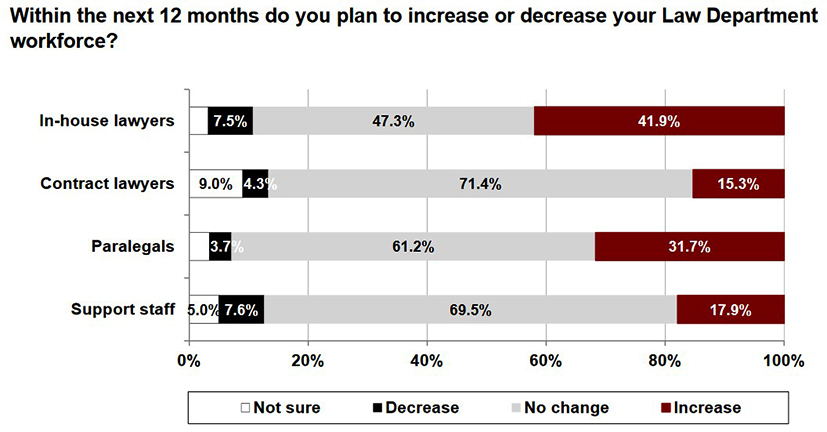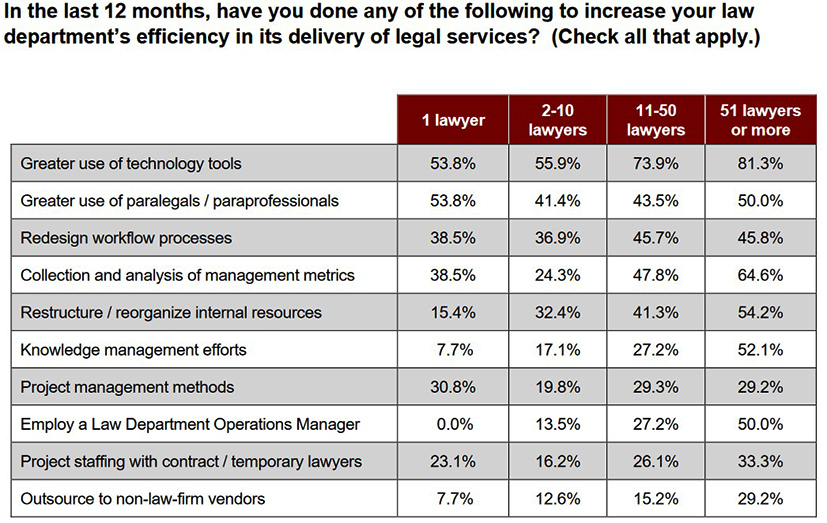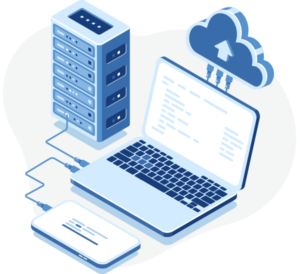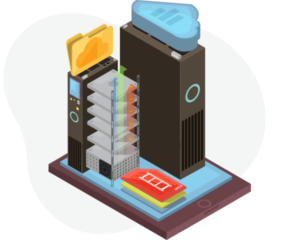HOW TO CHOOSE MATTER MANAGEMENT SOFTWARE FOR IN-HOUSE COUNSEL
A complete Guide for Legal Departments searching for a solution

According to a recent 41 country study by the Association of Corporate Counsel, there is an uptick in the number of legal departments planning to hire more staff. The two most frequently cited reasons for this trend are company growth and a desire to limit outside counsel spend by shifting work to internal resources.
As more work comes in-house, department leadership is challenged to actually deliver these cost reductions by managing the efficiency and productivity of a growing operation – all while delivering a high level of service in the role of legal advisor to the organization.
As a result, Legal Departments are becoming more aggressive about leveraging best-of-breed technology to help them run their department.

The centerpiece of in-house legal technology is the matter/case management system.1]. If you are reading this guide chances are that you are either looking to implement such a system, or you are looking to switch from your existing software.
In this guide, we will discuss key considerations that affect both scenarios. We will also identify differing approaches that may be needed according to your situation.
How is Case Management Software Different from Matter Management Software?

Generally speaking, case management tends to refer to systems used by law firms while matter management refers to in-house legal department solutions. The distinction is somewhat muddied because the terms are often used interchangeably.
To further complicate the situation, some developers use ‘litigation management’ as another moniker for case management systems, and some evidence management systems are marketed as ‘case management’ tools.
In this guide, we will use ‘matter management’ and ‘case management’ interchangeably when referring to in-house solutions, and we will note when we are referencing law firm-oriented systems.
What Problems Does a Matter Management System Solve?
Corporate matter management systems are designed to streamline legal operations and improve the delivery of advice and counsel. They can help the management of the legal function by:
♦ Standardizing legal department workflows to reduce risk, assign tasks to appropriate staff and improve productivity
♦ Simplifying and adding structure to new matter intake and setup
♦ Creating a platform with programmatic rules to enforce legal department policies
♦ Providing department leadership with financial, operational and staffing data through reports and dashboards, and with notifications of critical case or departmental developments (e.g. an important contract renewal date, red flag events like the dismissal of a high-profile motion, budget to actual legal spend)
♦ Tying outside counsel billings to case status information and flagging issues
♦ Serving as the source for companywide or departmental compliance and governance initiatives (e.g. SOX, SEC reporting, internal audit, health and safety, environmental)
♦ Integrating with other corporate technology and business functions to improve productivity
How Do Law Firm Case Management Systems Differ?

Case management systems for a law firm may include features for time and billing, conflicts checking, client invoicing, trust accounting and marketing.
They are often heavily focused on the status of individual matters, with very granular records about docket dates and case contacts. They can also be focused on specific practice areas such as insurance defense, family law, personal injury or bankruptcy.
Most of these systems are marketed to smaller law firms and solo practitioners.
Some law firm case management vendors claim that their solutions also work for in-house counsel. Proceed cautiously if you are working with such a vendor. Corporate legal departments often end up wasting valuable time and budget experimenting with programs that are not a clean fit.
A better option is to work with a vendor with expertise in the nuanced needs and business processes of a legal department.
Which Key Features Are Important for In-house Use?

♦ They are designed specifically for in-house use. They should capture and track the types of information most relevant to a business’ legal portfolio. For example:
o Matter status updates
o Legal spend details
o Matter and organizational risk profiles
o Contract renewal data
o Litigation routing guidelines
o Legal hold and document retention requirements
o Outside counsel and service provider data
♦ They are flexible, accommodating differing information and workflow needs according to the type of matter being supported (e.g. litigation, contract administration, transactions, intellectual property, labor/employment, special projects).
The system should also be able to handle bespoke workflows for specialized corporate needs.
♦ You see both the forest and the trees. The systems are designed for the management of individual legal matters and global oversight of in-house operations.
The solution should support tasks like management status reports, budget/financial roll-up reporting, staff caseload summaries, workflows for routing and escalation, and critical event notifications.
♦ The better solutions combine matter management features with contract management, legal spend and document management features.
♦ There is a high level of integration with standard corporate IT tools such as email/messaging, productivity and collaboration platforms (i.e. applications such as Outlook/Exchange, Office, Office 365 and SharePoint).
♦ Decision support tools in the form of reports and drill-down dashboards are built-in and dynamic. By dynamic, we mean that the system should generate reports that meet the regular and on-demand needs of the General Counsel, upper management and line staff.
The reporting tools should be configurable, allowing users to focus on the metrics and key performance indicators that make the most sense for their department.
♦ Cyber security and general IT concerns merit particular attention when selecting a matter management solution. Legal departments’ typically have to work within a companywide IT framework, that includes security protocols.
In-house IT requirements are usually more sophisticated than those of a small or solo law firm.
What is a ‘Complete’ Case Management Solution?
As previously noted, the best-in-class matter management systems are multi-disciplinary. They bring together functionality that used to be sold as separate, stand-alone applications. Legal departments should expect to find ‘complete” matter management systems that also function as:
♦ Document/File Management Systems
How do Legal Departments Benefit from a Complete Solution?
It is unusual to find an in-house attorney who is not extremely busy. Survey after survey shows that demand for in-house legal expertise is growing. Many law departments struggle to keep up with the increasing workloads. They place a premium on staff efficiency.

A complete matter management system will increase efficiency by bringing multiple activities under a single umbrella. According to the American Psychological Association, a worker loses up to 40% of her productive time when switching tasks.
Workers are happier and less harried when they can complete multiple tasks without switching applications. This is particularly true when data entry redundancies are eliminated. Working with a single application also eliminates the need for kludgy workarounds and the errors that can result from data discrepancies.

♦ User interaction is simplified, even as functionality is increased. For example, an attorney can update the status of an upcoming hearing for a litigation matter and quickly switch to check a contract file, including the underlying documents – all from the same system.
♦ The various system is run off a single database. This means that case-related information such as matter numbers, dates, notes, staff assignments and contacts are entered only once.
Since the information is not siloed into separate databases, it is available for a variety of cross-functional applications., Also, separate data sets do not need to be synchronized to maintain system consistency and integrity.
♦ Matter related documents such as memos, spreadsheets and emails can be attached to a case record and will be visible and accessible from the combined system.
This will provide a place to archive documents and emails related to ongoing matters. Attorneys will be able to reference these documents on screen while working on a case file.
Users will also be able to search for documents without leaving the system (i.e. the need to separately search network, cloud and email folders is eliminated).
♦ Budgetary and billing detail can be reviewed alongside other records related to matter status.
♦ Rolled-up management reporting and dashboards are driven off a single database. The need for analysts to collect and combine data is reduced.
♦ Cross-functional workflows can be created to delegate tasks, increase productivity, and reduce the possibility that errors will occur.
The result will be a legal department running on all eight cylinders, with a fully integrated system driving time savings, cost savings and efficiency.
Please click on the button to evaluate your needs for a Case Management Software
What are the Disadvantages of Modularized Systems?
Be wary of software providers that offer piecemeal, modularized solutions. A module may be tailored for a particular individual function, but overall system performance may fall down when working across modules.
For example, a vendor may have separate modules for case management, litigation management E-billing and document management. If the integration is not tight, there will be duplicated data entry, redundant system administration efforts, inconsistencies in shared data elements and a high level of user dissatisfaction.
Operating the system begins to feel like solving a jigsaw puzzle.

Implementation can also become an expensive proposition. The complexity of implementation (and associated expenses) grow when disparate applications needs must be pieced together. Training costs also go up. Users must learn the nuances of multiple systems and of the manual workarounds that must be put in place to get modules to work together.
Finally, there tend to be information and workflow overlaps with poorly integrated modular systems. Users become confused and frustrated when they are forced to wade through unnecessary screens or fill-in duplicative data elements.
What Else Should be Considered When Assessing Case Management Software?
After weighing the foundational matter management features and assessing the resilience of the four pillars of an ideal system (i.e. integration with a) E-billing, b) document management, c) contract management, and d) email/corporate IT systems) the following considerations should be taken into account.
When is a Cloud vs. On-premise Solution Preferable?

♦ Cloud-based systems are set up on platforms that are maintained by the developer or a third party. Legal department users access the system remotely, typically over the Internet.
Cloud delivery models vary, but generally much of the system, database and infrastructure administration is outsourced to the cloud provider. The range of cloud hosting models includes:
o Software as a Service (“SaaS”) – where almost all system functions are performed by the cloud provider
o Infrastructure as a Service (“IaaS”) where the provider only supports the underlying hardware that runs the platform
♦ On-premises systems are installed on the end customer’s equipment, behind the customer’s firewall. System administration and maintenance are handled by in-house IT staff or contractors.
Over the last few years, legal departments have aggressively adopted cloud-based technologies. The benefits of cloud-based systems can include predictable costs, a reduction in staffing needs, verifiable, highly secure computing and reliability/uptime levels that can exceed 99.99%.
Cloud systems also allow a legal department to cut through the red tape and the delays that come with on-premises implementation. New systems can be up and running very quickly. It is not unusual for cloud vendors to roll out new matter-management software to groups of up to 25 users within a few weeks.
The cloud model also reduces the need for expensive, in-house IT staff. Because of economies of scale, the cloud provider will be able to maintain a deeper bench system-specific technical expertise than most corporate clients are able to.
Routine system administration, event management, updates and change requests are handled by vendor staff. Cloud-based deployments can also be used to mitigate cross-border privacy risk.
As a result, 9 out of 10 legal departments prefer to have a cloud-based matter management system.
On-premises deployments are most often found at two types of companies.
♦ Highly regulated businesses[1] that are strongly incented or even legally bound to maintain on-premise software
♦ Companies that are skeptical about a cloud provider’s ability to deliver an appropriately secure environment
On-premise systems have their own advantages and disadvantages. They allow a company to maintain its data locally. This can be critical to protection of trade secrets or compliance with privacy regulation.
Sarbanes Oxley (SOX) or the Health Insurance Portability and Accountability Act (HIPAA).

The downside is that on-premises software can be costly and difficult to maintain. It may also be difficult to attract and retain the systems experts needed to keep an in-sourced system running.
While security concerns often drive the decision to adopt on-premises solutions, many reputable cloud providers offer a level of security that exceeds those of their clients.
Why is Compatibility with Office 365 Important?

Attorneys and legal staff tend to ‘live in’ this software during business hours. For companies that have not moved to Office 365, integration with in-house implementations of Office and Outlook/Exchange may be possible.
It is of critical importance that a matter management system be able to work in conjunction with the Office 365 or on-premises services. The better vendors have built their software using Microsoft’s development toolkits to provide features like:
♦ Workflow supported by email and calendar integration
♦ Matter records with seamless access to emails and other digital documents
♦ Tracking of email conversation threads
♦ Being able to open case files from within Outlook
♦ Collaborating with legal department, corporate or even outside counsel team members on matters or projects
How Customizable Should a Matter Management System Be?
Many software vendors love to claim ‘Our software is fully customizable!’
This claim should be scrutinized when assessing a case management system. As noted above, the ability to customize is critical when fitting a system to your particular needs. There is a sliding scale used to define ‘customization’, so be wary of marketing claims.
The abilities to add a bunch of fields (text boxes, date pickers, notes area) or to change colors, icons or screen sizes are at the low end of the usefulness scale. Systems that also allow rule-building and workflow configuration are far more valuable.
A matter management solution should be able to accommodate your company’s processes via database configuration, programmable rules, workflow settings and other customizations. Consider the following scenario.
Scenario: Workflow Designed for Risk Management
Horizon International’s legal leadership would like their case management software to send auto notification to the General Counsel in the case of critical upcoming deadlines related to pleadings and depositions.
They also want the software to generate flags and automatically execute certain follow-up task assignments when one of these important case milestones is approaching.
Finally, they want the system to report on the combined status of these tasks on a litigation management dashboard. All of these steps are a part of Horizon’s day-to-day case management workflow and can be accomplished when a matter management system allows customization of rules and parameters.
The system should be flexible enough to adapt to changing in-house legal needs. Specialized types of workflows are also required for contract management and other matters non-litigation.
Do Legacy Systems and Processes Affect the Decision?
The needs of first-time systems users differ from those of legal departments with legacy case management solutions.
What Should First Time Users Focus On?

Change management must be handled. You must ensure that your stakeholders are on board.
The first group of stakeholders includes the legal department attorneys and staff. These day-to-day users must be willing to embrace the change and use the software according to established guidelines. Typically, paralegal and support staff are quick to master the software.
They often welcome it as a work-saving tool. The challenging group is almost always the senior attorneys who can be skeptics. Their buy-in will be critical to the success of the system implementation.
A systems assessment team should take adequate time to understand current workflows and information requirements and to help senior counsel appreciate the benefits of automating aspects of matter management.
Other stakeholders include upper management, business unit leaders, IT management and members of departments that routinely interact with Legal (e.g. Accounting, Compliance, Risk Management). Make sure you understand legal reporting requirements from the C-suite and the board.
Also pay particular attention to the information exchange requirements of other departments, whose systems must interact with the new matter management solution. Systems administrators and managers from these departments should be included in system planning, as should IT.
If you will be instituting E-billing, you should consult with outside counsel and legal service providers to understand their concerns and garner buy-in.
How is This Different for Legal Departments Looking to Switch?

It is usually much easier for the legal staff to switch to a new matter management system as they are already used to using technology to manage matters. Particular attention should be paid to stakeholder concerns over current pain-points that a new system can alleviate.

The assessment team should also understand the legacy data migration needs. Migration costs can balloon quickly. There is rarely a clean, full migration between systems. The impact of the inevitable loss of certain legacy records or data elements must factor into your system selection.
It is critical to map data elements from the old to the new system and to understand the level of effort that will be required to migrate data. Confirm the new vendor’s capabilities when it comes to data migration.
Determine whether you will have to dedicate in-house resources or bring in third parties to support data migration. We strongly recommend that these steps occur sooner rather than later during the selection process.
How Can You Justify a Case Management Investment to Corporate Management?

It has been our experience that matter management subscription costs are usually a small fraction of the salary that would be paid to a legal staff member supporting a kludgy or manual system.
Your staff and your vendor will be able to help you forecast the hours that will be saved when moving to the new matter management system.
A second cost justification may be found in the amount of attorney time that is freed up. Reductions in administrative tasks leave more time to focus on substantive legal concerns. You can compare the cost of in-house advice and counsel to outside counsel fees for the same work.

Improved risk management is another benefit that comes when using matter management software. It is a difficult benefit to cost-justify, but upper management and boards will recognize the potential exposure that can result from impaired legal management capabilities.
The impact on group calendaring and event notification will have a significant positive impact on litigation, contract and IP management activities.
Legal department leadership and corporate management also benefit immensely from the enhanced legal spend report/dashboards that come with a matter management system. General Counsel and senior management will have improved access to legal information needed to make informed business decisions.
The scope of new information ranges from timely budgeting forecasts to litigation status updates that drive settlement decisions. Since the collection of information is more timely, particularly with legal spend management data, the General Counsel is able to adapt quickly, formulating new strategies to minimize problems before they spin out of control.
Better data also helps the General Counsel with decisions based on caseload analysis, performance analysis, case life cycle analysis and staff recruitment projections.
Finally, enhanced information sharing capabilities will streamline operations inside and out of Legal. Automated data interfaces can pass information to and from the matter management system and the systems used by accounting & finance, risk management, human resources, compliance, etc. The automated interfaces reduce the need for manual data entry or cleanup, limit the potential for data errors and omissions, and speed up transaction times.
Conclusion
There are excellent Corporate Legal solutions available in the market. Many will be well suited to your department’s specific needs. We hope that this guide has informed your search for and helped direct you toward the best fit.




